GLBenchmark 2.5 Performance on Modern Android Smartphones & Tablets
by Anand Lal Shimpi & Brian Klug on July 31, 2012 10:00 AM EST- Posted in
- Smartphones
- GLBenchmark
- Mobile
- Tablets
- SoCs
For quite a while now, GLBenchmark has been a regular test in our smartphone, tablet, and SoC reviews. As GPU performance has steadily increased, GLbenchmark 2.1.x started hitting vsync more of the time in onscreen tests, necessitating an updated version of the test with heavier assests, reworked rendering code, and improved functionality for testing. Today Kishonti Informatics has released GLBenchmark 2.5.0 both on the Google Play store and to partners, and we're taking a first look at performance across the current crop of devices.
GLBenchmark 2.5.0 primarily addresses a few shortcomings from the previous version of the Egypt test, primarily by moving to a more challenging version of Egypt. The new game test is named Egypt HD, and moves to a much more complex scene while keeping roughly the same test animation. Geometry count has increased, texture resolution has increased, there's a new water shader, more reflections, and more shadowing. In addition, the offscreen test has now moved to a default resolution of 1080p instead of the previous 720p, for a more challenging workload. This offscreen resolution is now customizable, but we'll be running 1080p for ease of comparison. In addition, the "classic" Egypt test is also a part of GLBenchmark 2.5.0 for those wishing to compare to 2.1.5. In addition, the triangle and fill subtests also stay around for a lower level look at OpenGL ES 2.0 performance. It should go without saying, but GLBenchmark 2.5 is still an OpenGL ES 2.0 test.
We've run GLBenchmark 2.5.0 on all the devices we have on hand, and have split up the results between tablets and smartphones for ease of comparison. The iOS version of GLBenchmark 2.5.0 is still in the review process, and we'll be updating as soon as we can run that on our iPhone 4S, iPad 2, and iPad 3. For now however, we have a good look at performance for the latest devices in Android land.
Tablets
We have three major SoCs making up our tablet test candidates: NVIDIA's Tegra 3, NVIDIA's Tegra 2 and TI's OMAP 4430. When we get the iOS versions of GLBenchmark 2.5 we'll be able to add the A5 and A5X to this list. We're also waiting on our own Qualcomm MDP/T, which will let us add Adreno 320 results in a few weeks.
The fill and triangle rate tests show us just how far we've come since the days when Tegra 2 and the PowerVR SGX 540 were considered cream of the crop. NVIDIA's Tegra 3 is just significantly faster across the board. The Transformer Pad Infinity's added memory bandwidth (DDR3-1600) helps propel it above the other, lesser Tegra 3 configurations. Again there's nothing new here, just new data that validates what we've already known.
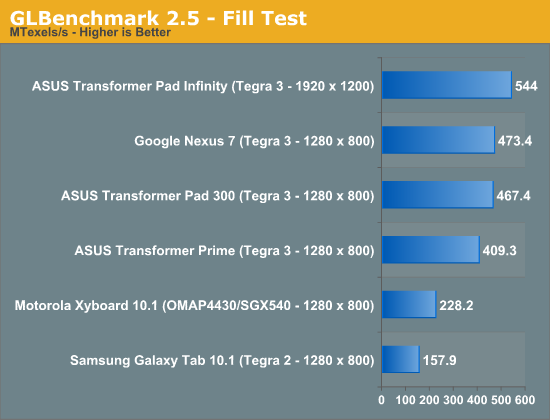
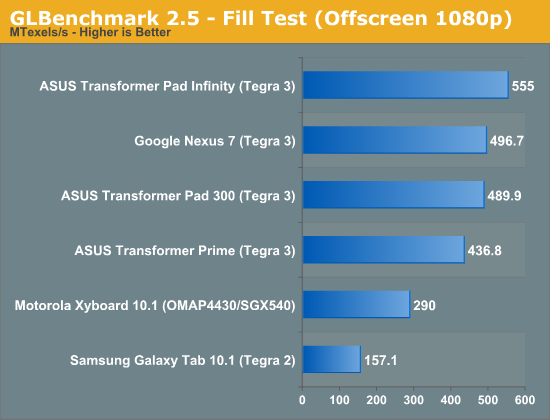
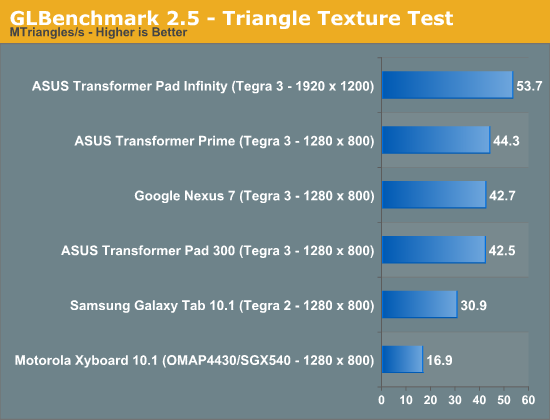
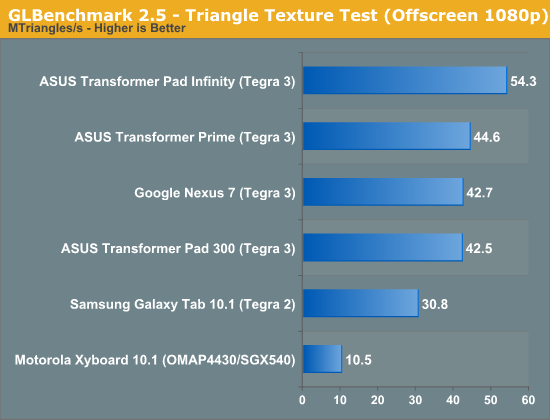
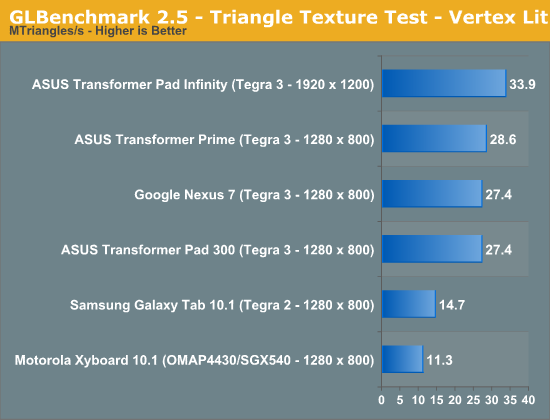
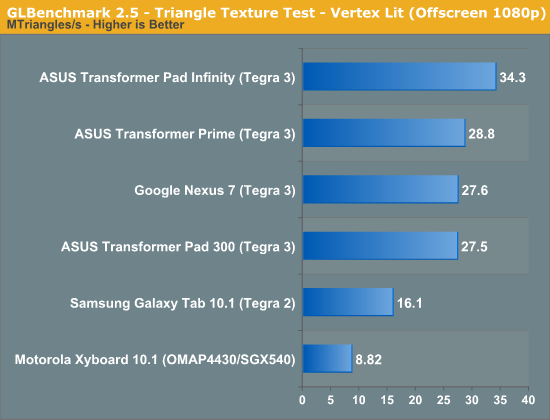


The Egypt HD test raises the bar for what is necessary to produce playable frame rates. At their native resolutions, none of these tablets can even deliver half of a playable 30 fps frame rate. For the next generation of games, we'll need performance around 3x better than NVIDIA's Tegra 3. Qualcomm's Adreno 320 has the ability to deliver that depending on the workload, so it's possible we may see > 30 fps results from it. The A5X should be able to break 30 fps as well, but we'll find out for sure in another day or so.
The offscreen results are even worse. Tegra 3 with DDR3-1600 is still only good for 11 fps. It shouldn't be any surprise, but we will need faster GPUs for better looking games. Egypt HD is definitely the new torture test for mobile SoCs.
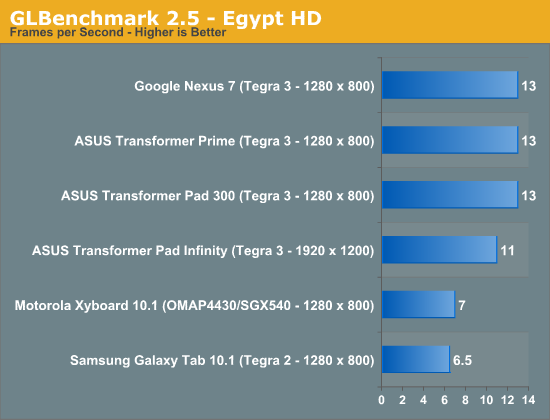
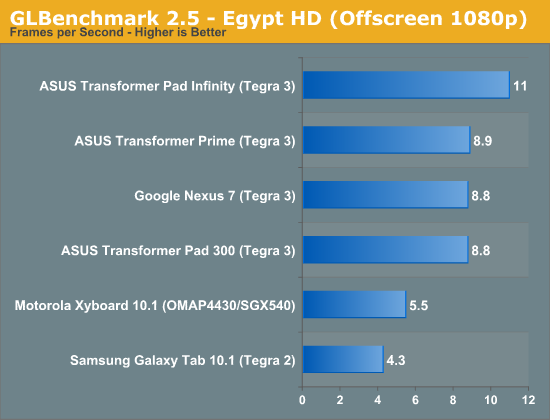
The Egypt Classic test ends up being Vsync limited on the 1280 x 800 Tegra 3 tablets, with even 1920 x 1200 running smoothly on the Transformer Pad Infinity. These numbers echo the reality of 3D gaming on Android today: pretty much everything runs well on Tegra 3.
The same can't be said for Tegra 2 or OMAP 4430 however, even at 1280 x 800 both of these SoCs deliver frame rates well below 30 fps.
The offscreen 1080p results paint a good picture for Tegra 3, which again can deliver average frame rates at or above 30 fps. Anything older than Tegra 3 however just can't pull it off.
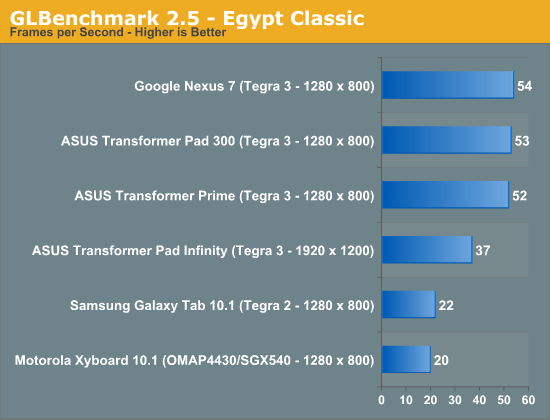


















47 Comments
View All Comments
Stormkroe - Tuesday, July 31, 2012 - link
Performance improvements have caused vsync to get in the way of glbenchmark 2.1 numbers on the Galaxy S2Galaxy S2
Egypt HD 23.4fps
Egypt HD 720p offscreen 21.7fps
384k vs 921k pixels 240% workload, still 93% score
Galaxy Note
glbenchmark 2.1
Egypt High (1280x800) 48.1FPS
Egypt Offscreen (1280x720) 72.3FPS!!
1024k vs 921k pixels 90% workload, 150% score (newer scores, while too high, are no longer double, my bad)
Galaxy Note
GLbenchmark 2.5
Egypt HD (1280x800) 16.5FPS
Egypt HD (1920x1080) 15.9FPS
1024k vs 2073.6k Pixels 202.5% workload, still 96.4% score
Galaxy S3
Egypt HD (1280x720) 23.9FPS
Egypt HD (1920x1080) 23.7FPS
921k vs 2073.6k Pixels 225% workload, still 99% score
The GS2 and GS3 continue the trend of scoring almost the same while more than doubling the workload (only difference being the doubled workload is offscreen)
I included the galaxy note because it's native screen resolution of 1280x800 is very, very close to the offscreen resolution in GLbenchmark 2.1, making apples to apples very straightforward and eliminating vertex shader architecture as the culprit.
I got these scores from glbenchmark's site to give you as much detail as I could on short notice, it confirms the trend that shows in the AT reviews.
Hopefully this helps :)
metafor - Tuesday, July 31, 2012 - link
"I included the galaxy note because it's native screen resolution of 1280x800 is very, very close to the offscreen resolution in GLbenchmark 2.1, making apples to apples very straightforward and eliminating vertex shader architecture as the culprit."What's the line of reasoning here? Vertex or front-end limitations are fairly resolution independent (not entirely independent depending on the scene). And more importantly, GLB 2.1 didn't necessarily have the complex shaders to bottleneck Mali400.
The only time performance doubled when going offscreen is when the framerate hits the vsync limit during the on-screen test (GS2 in GLB 2.1).
Stormkroe - Tuesday, July 31, 2012 - link
You said the inconsistency could be because of a vertex shader weakness in Mali400.The reasoning behind listing the GL2.1 galaxy note scores is that we have a perfect example of NOTHING changing but the state of 'offscreen rendered' vs 'onscreen rendered', yet offscreen scores jump to 150% of onscreen scores. (I apologized for the lack of score doubling in my last post, as the numbers have become more even since I posted about this many months ago.
So, in a nutshell, Exynos score jumps to 150% by simply switching from onscreen to offscreen, with NO OTHER VARIABLES.
No that GL2.5 defaults to 1080p for offscreen, I've got no other way to compare on/offscreen evenly.
If you know of an exynos tablet with a 1080p res, we can do a straight apples to apples comparison with gl2.5, which judging by the gs2/3/note scores, will be a repeat of skyrocketing offscreen.
leexgx - Tuesday, July 31, 2012 - link
come one we do not want this comment box getting very small do wemetafor - Wednesday, August 1, 2012 - link
"The reasoning behind listing the GL2.1 galaxy note scores is that we have a perfect example of NOTHING changing but the state of 'offscreen rendered' vs 'onscreen rendered', yet offscreen scores jump to 150% of onscreen scores. (I apologized for the lack of score doubling in my last post, as the numbers have become more even since I posted about this many months ago.So, in a nutshell, Exynos score jumps to 150% by simply switching from onscreen to offscreen, with NO OTHER VARIABLES."
Erm, vsync. Like I said, when numbers come close to 60fps, the averages will vary a lot since the on-screen numbers will clip during high framerate times. That should be quite obvious....
edlee - Tuesday, July 31, 2012 - link
umm, how come there are a bunch of soc's missing from the test??Exynos + Mali 400
Qualcom + Adreno 220
Stormkroe - Tuesday, July 31, 2012 - link
It's all on the second page, except adreno 220 hasnt ever got a fix for 2.1 to run the offscreen game benches. Not sure if it works yet on 2.5.A5 - Tuesday, July 31, 2012 - link
I'm running it on my Adreno-220 EVO 3D right now. Will post in a second.A5 - Tuesday, July 31, 2012 - link
It looks like it falls in somewhere around 2/3rds of the Adreno 225's performance. They actually have a pretty decent comparison tool on the glbenchmark.com site.Stormkroe - Tuesday, July 31, 2012 - link
That's the same phone I have. Good to hear that it's finally working. Do you have the updated you drivers in your phone? They make an enormous difference for games. I'd be interested in your scores.